Do you have a question about the Siemens KG39EAI43 and is the answer not in the manual?
Provides essential information and guidance for performing repair work.
Defines warning levels and hazard symbols used throughout the document.
Specifies the necessary qualifications for personnel performing repair work.
Outlines general safety precautions applicable to all domestic appliances.
Details safety information specific to refrigeration and freezer appliances.
Lists necessary checks and actions to be performed after completing a repair.
Explains the European energy label for home appliances and its components.
Describes different cooling zones within the appliance and their intended food storage.
Details the function and types of speed-controlled compressors used in appliances.
Explains the role of the dryer in the refrigeration circuit and types available for repair.
Describes different types of hinges used for appliance doors, including weight limits.
Explains the Lokring technology for restoring cut pipe connections in refrigeration circuits.
Describes the function of the winter switch for maintaining freezer compartment temperature.
Details the iService software tool for appliance diagnosis and repair support.
Lists and describes essential tools for repairing refrigeration circuits.
Lists and describes tools specifically for repairing water circuits.
Provides tools and aids for supporting appliance installation and de-installation.
Details various measuring devices used for appliance diagnostics and performance checks.
Lists accessories for cleaning and maintaining appliance surfaces and components.
Troubleshooting guide for faults related to condensation, humidity, and leaks.
Troubleshooting guide for faults related to the appliance's compressor.
Identifies and provides solutions for mechanical damage issues like rust and discoloration.
Troubleshooting guide for issues arising from incorrect installation of the appliance.
Diagnoses and provides solutions for various types of noises produced by the appliance.
Addresses common causes and solutions for unpleasant odors within the appliance.
Troubleshooting for issues related to the appliance's output or results, like water taste.
Guides on diagnosing and resolving temperature-related issues within appliance compartments.
Details methods for accurately measuring internal appliance temperatures.
Describes how to measure temperature using a thermometer without a data logger.
Explains how to use nominal temperature graphs for performance comparison and troubleshooting.
Procedure to check the temperature indicator sticker for correct cooling zone settings.
Provides instructions and prerequisites for measuring the appliance's energy consumption.
Instructions for executing the on-board customer service test program for diagnostics.
Methodology for detecting leaks within the appliance's refrigeration circuit.
Procedure for a quick diagnostic test of the compressor's functionality.
Steps for checking the functionality, leaks, and power consumption of the stop valve.
Detailed guide on using Lokring technology for pipe connections.
Procedure for flushing the refrigeration circuit to remove blockages.
Specific instructions for repairing refrigeration circuits using R600a refrigerant.
Guidelines for the safe disposal of R600a compressor oil containing refrigerant.
Steps for preparing and measuring R600a refrigerant for filling circuits.
Procedure for evacuating the R600a refrigeration circuit using a vacuum pump.
Instructions for filling the R600a refrigeration circuit with refrigerant.
Specific instructions for repairing refrigeration circuits using R134a refrigerant.
Guidelines for the safe disposal of R134a compressor oil containing refrigerant.
Procedure for filling the filler cylinder with R134a refrigerant.
Procedure for evacuating the R134a refrigeration circuit using a vacuum pump.
Instructions for filling the R134a refrigeration circuit with refrigerant.
Instructions for sanitizing the appliance's water system, including ice maker and dispenser.
Procedure for applying brand logos to appliance surfaces, including preparation and application steps.
Tips and advice for reducing the appliance's energy consumption.
Guidance on proper food storage techniques to maintain freshness and air circulation.
Advice on when and how to defrost the freezer compartment to prevent excessive ice build-up.
Important considerations before commissioning the appliance after transportation.
| Child lock | - |
|---|---|
| Door hinge | Side by side |
| Product color | Metallic |
| Reversible doors | Yes |
| Appliance placement | Freestanding |
| Noise level | 38 dB |
| Climate class | SN-T |
| Total net capacity | 339 L |
| Total gross capacity | - L |
| Fridge net capacity | 250 L |
| Number of vegetable drawers | 1 |
| Fridge number of shelves/baskets | 5 |
| Star rating | 4* |
| Freezer position | Bottom-placed |
| Freezing capacity | 14 kg/24h |
| Freezer net capacity | 89 L |
| Storage time during power failure | 35 h |
| Connected load | 160 W |
| Annual energy consumption | 156 kWh |
| Depth | 600 mm |
|---|---|
| Width | 650 mm |
| Height | 2010 mm |

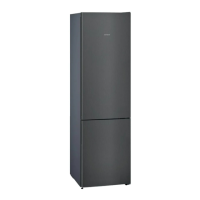
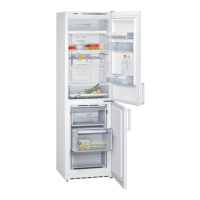
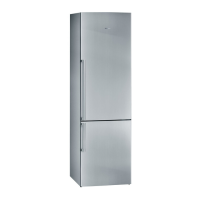





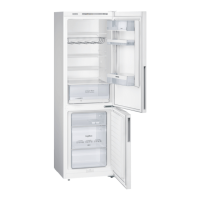
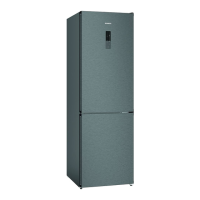

